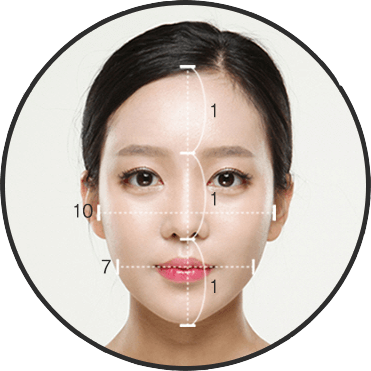For those who do not already know, your face shape is actually an important influence in determining your overall image. And one of the most desired type of face shape in Korea is a small and slim v-line face shape – small, oval-shaped face with a well-defined and pointy chin.
Because having a small, v-line face not only makes you look younger and more attractive, but also more feminine. So, if you are not born with your ideal face shape, there is only one thing you can do to get a smaller face – get a facial contouring surgery.
What is facial contouring surgery?
Facial contouring surgery is a cosmetic surgery procedure that transforms your face shape by modifying your cheekbones, jaw bones and/or chin. It might involve shaving or cutting of bones, lifting of saggy skin, and/or removal of fat tissues in your lower face.
It is popular among those who seek to:
- Have a smaller face
- Make their face line more v-shaped
- Soften angular jawlines which make their faces look masculine
- Correct crooked or asymmetrical jaws
- Get rid of wide and round chins
- Fix their protruding mouths
Because there are several types of facial contouring procedures, depending on your current face shape, bone structure, muscles and tissues, you might need to undergo more than one type in order to achieve your ideal face shape. So, what’s the ideal face shape?
Golden ratio of the perfect v-line face shape
With the correct facial proportions and symmetrical face shape, you will, no doubt, look more attractive, feminine and younger. Here’s the optimal ratio for the perfect v-line face:

Golden ratio for forehead to eyebrow to tip of nose to chin is 1:1:1, and the width of your jawline should be 0.7 times of the width of your cheekbones.

Ogee curve of beauty is the double S-shaped curves which gives your face contour and dimension from a 45° angle.
Types of facial contouring surgery
1. Cheekbone reduction (Zygoma reduction)
Having excessively prominent or overly protruding cheekbones will make your face appear to be bigger, and makes you look older and fiercer.
Cheekbone reduction surgery, commonly known as zygoma reduction surgery, is a procedure used to reshape your cheekbones. It involves the cutting, shifting and rotating of your cheekbones to reduce the width of your face and have a smoother contour.
Cheekbone reduction surgery is suitable for those who:
- Have protruding cheekbones which are not proportionate to the rest of their facial features
- Appear to have a large face due to their prominent cheekbones
- Look older or harsher due to their protruding cheekbones
- Appear to have sunken cheeks or temples due to protruded cheekbones
- Want to improve their flat face look due to wide side cheekbones
2. Square jaw reduction surgery
Square jaw reduction surgery is a procedure used to reduce the width of the lower face and altering a square or angled jaw into a slimmer v-shaped one. It is is performed by shaving down angled and excessively wide jaw bones, then sculpted to its desired facial contour.
Square jaw reduction surgery is suitable for those with:
- Angular and square jawline that is giving off a strong masculine look
- Imbalanced or asymmetrical jawline
- Elongated jaw
- Round and wide or flat jaw
3. Genioplasty (Chin surgery)
Genioplasty or chin augmentation is a cosmetic procedure that involves repositioning or reshaping the chin to improve facial harmony and enhance its shape.
Chin augmentation surgery is suitable for those who have:
- Excessively protruding or long chin
- Receding or undeveloped chin (short chin)
- Bulky or undefined chin
4. V-line surgery
V-line jaw surgery is actually the combination of square jaw reduction surgery and genioplasty. It involves the repositioning and reshaping of the jaw as well as the chin in order to achieve a slim and smooth v-line from your ears to the tip of your chin.
V-line surgery is suitable for those who have:
- Square or wide or angular jaw
- Flat jawline
- Long jaw which is not proportionate to their facial features
- Had square jaw reduction surgery but the results are not dramatic enough
5. Double jaw surgery (Two jaw surgery)
Double jaw surgery, also known as two jaw surgery or bimaxillary osteotomy, is a type of corrective jaw surgery which involves both the upper jaw (maxilla) and lower jaw (mandible). Its purpose is to correct all functional and aesthetic issues by resizing, reshaping or repositioning the upper and lower jaws and aligning them.
Double jaw surgery is suitable for those with:
- Severe protrusion of both upper and lower jaw
- Abnormal bites that braces cannot correct
- Incorrect jaw position and size
- Jaw deformities
- Severe jaw misalignment
- Asymmetrical face
- Short or receding or retreated chin
- Lantern jaw – Lower jaw is larger or bulging out further than upper jaw
6. ASO (Anterior segmental osteotomy) surgery
ASO jaw surgery is a corrective jaw surgery which involves only the upper jaw. Typically, excess bones at the upper jaw is shaved away and in some cases, excess molars are also removed.
ASO jaw surgery is suitable for those who have:
- Significantly receded or protruded upper jaw
- Too much or too little teeth showing
7. BSSRO (Bilateral sagittal split osteotomy) surgery
BSSRO jaw surgery is a corrective jaw surgery which involves only the lower jaw. It is performed by retracting or rotating your lower jaw into correct alignment with your upper jaw so that it is ideally balanced with the proportions of your face.
BSSRO jaw surgery is suitable for those who have:
- Receding lower jaw
- Protruding lower jaw
Benefits & risks of facial contouring surgery
Benefits of facial contouring surgery:
- Improves and enhances your facial contours
- Enhances the overall facial proportions and balance
- Improved function of your teeth (esp. for asymmetrical jaws)
- Psychological benefits such as improved confidence, positive self-image etc.
- Health benefits such as improved sleep, breathing, chewing and swallowing
- Improvement in speech impairments
Risks of facial contouring surgery:
- High-risk surgery
- Results are not reversible (which could be a benefit too)
- Droopy or saggy jowls if a lot of bones are being removed (but can be fixed with treatments such as thread lift, SMAS lift or facelifts)
How long do results of facial contouring surgery last?
The results of facial contouring surgery are permanent and lasts for a lifetime. Once you cut off the excess jawbones, it will not regrow, so make sure that you really want the surgery before getting it. That said, be careful not to overdo it as well!
Do take note that the success of your facial contouring surgery not only lies in the hands of your surgeon but also how you well you recover after surgery. So learn how to properly care for yourself during the recovery period by reading our article on facial contouring surgery aftercare and post-op instructions.
Alternatives for facial contouring surgery
An alternative to facial contouring surgery is jaw botox. However, jaw botox is only effective in making your face appear smaller if it is your jaw muscles which causes your wide jaws. If over-developed bones are the problems to your large jaws, facial contouring surgery would be a better solution for you.
Conclusion
Needless to say, everybody is born with a different face shape, so there are cases where more than one type of facial contouring surgery is required to achieve your desired face shape.
And facial contouring surgery is considered a high-risk surgery because your jaw and cheekbone areas are full of nerves. So most importantly, make sure to get a meticulous and skillful plastic surgeon who is experienced in facial contouring surgeries. Because only an experienced surgeon will be able to tell which type of procedures is suitable for you and needed to produce your desired faceline.
anti-aging cosmetic surgeryanti-aging plastic surgeryanti-aging procedurechin augmentationchin surgery in koreacosmetic surgery in koreajaw surgery in koreaKorean face contouring surgerykorean jaw surgerykorean v-line surgeryplastic surgery in koreav-line surgery in korea









What do you think?